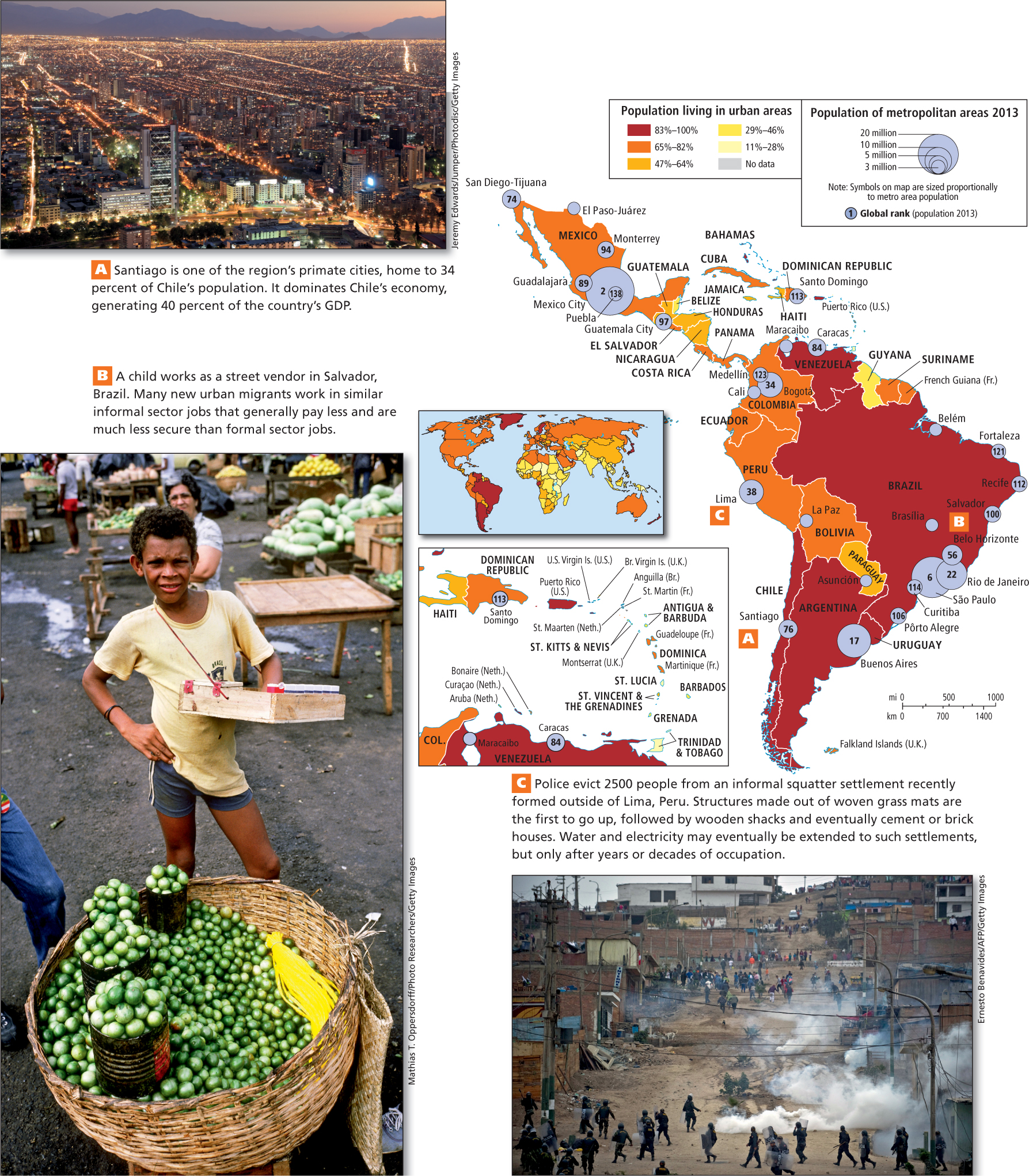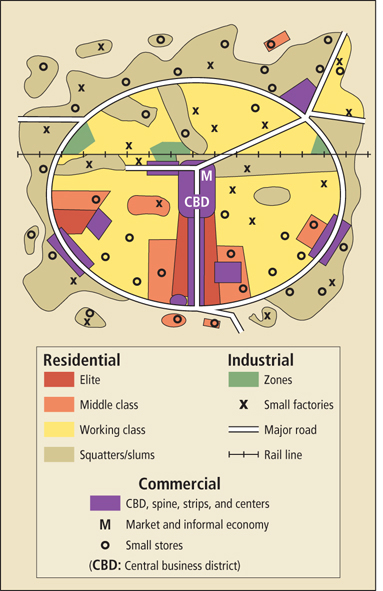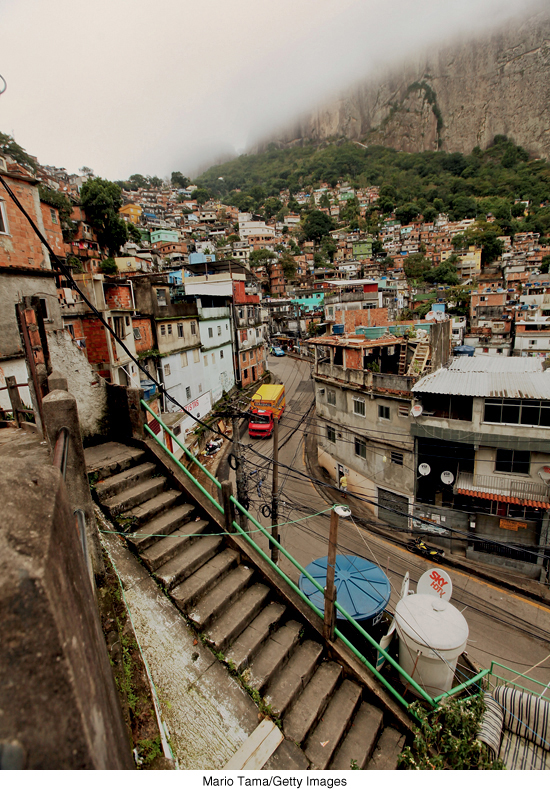3.7 URBANIZATION
GEOGRAPHIC INSIGHT 4
Urbanization: Since the early 1970s, Middle and South America has experienced rapid urban growth as rural people migrate to cities and towns. A lack of planning to acco m modate the massive rush to the cities has created densely o c cupied urban landscapes that often lack adequate support services and infrastructure.
More than 70 percent of the people in the region live in settlements of at least 2000 people. Increasingly, one city, known as a primate city, is vastly larger than all the others, accounting for a large percentage of the country’s total population (Figure 3.21). Examples in the region are Mexico City (with 23 million people, a bit more than 21 percent of Mexico’s total population); Managua, Nicaragua (33 percent of that country’s population); Lima, Peru (29 percent); Santiago, Chile (34 percent); and Buenos Aires, Argentina (36 percent).

THINKING GEOGRAPHICALLY
Use the Photo Essay above to answer these questions.
Question 3.16
A What about this picture suggests that there may be considerable wealth in Santiago?
Question 3.17
B Why might work in the informal economy be considered insecure?
Question 3.18
C What are some defining characteristics of “informal” squatter settlements?
primate city a city, plus its suburbs, that is vastly larger than all others in a country and in which economic and political activity is centered
The concentration of people into just one or two large cities in a country leads to uneven spatial development and to government policies and social values that favor the largest urban areas. Wealth and power are concentrated in one place, while distant rural areas and even other towns and cities have difficulty competing for talent, investment, industries, and government services. Many provincial cities languish as their most educated youth leave for the primate city.
Migration and Urbanization
It always takes some resourcefulness to move from one place to another. Those people who already have some years of education and strong ambition are the ones who migrate to cities. The loss of these resourceful young adults in which the community has invested years of nurturing and education is referred to as brain drain. Brain drain happens at several scales in Middle and South America: through rural-
brain drain the migration of educated and ambitious young adults to cities or foreign countries, depriving the communities from which the young people come of talented youth in whom they have invested years of nurturing and education
Urban Landscapes A lack of planning to accommodate the massive rush to the cities has created dense urban landscapes with often inadequate infrastructure. The arrangement of urban landscapes is also very different from the common U.S. pattern. In the United States, a poor, older inner city is usually surrounded by affluent suburbs, with clear and planned spatial separation of residences by income as well as separation of residential, industrial, and commercial areas. In Middle and South America, by contrast, both affluent and working-

Unplanned Neighborhoods The best known of these unplanned communities are Brazil’s favelas (Figure 3.23). In other countries they are known as slums, shantytowns, colonias, barrios, or barriadas. The settlements often spring up overnight on vacant land after a coordinated collective occupation by poor homeless families. They rarely occur with the landowner’s permission, and are without city-

THINKING GEOGRAPHICALLY
Question 3.19
Why are favelas often located on steep hills, and why do residents often store water on their roofs?
favelas Brazilian urban slums and shantytowns built by the poor; called colonias, barrios, or barriadas in other countries
The squatters are frequently enterprising people who work hard to improve their communities. They often organize to press governments for social services. Some cities, such as Fortaleza in northeastern Brazil, even contribute building materials so that favela residents can build more permanent structures with basic indoor plumbing. Over time, as shacks and lean-
Planned Elite Landscapes In contrast to colorful but problematic favelas are districts in nearly every city that are modern, planned, and similar to elite urban districts across the world. Examples of such urban landscapes can be found in Rio de Janeiro, São Paulo, and other cities in Brazil’s southeastern industrial heartland. These cities have districts that are elegant and futuristic showplaces, resplendent with the very latest technology and graced with buildings and high-
urban growth poles locations within cities that are attractive to investment, innovative immigrants, and trade, and thus attract economic development like a magnet
Planners throughout the region now acknowledge, however, that in the rush to develop modern urban landscapes, municipal governments and developers neglected to underwrite the parallel development of a sufficient urban infrastructure (for an exception, see the discussion of the southern city of Curitiba below).
VIGNETTE
Favelas are everywhere in Fortaleza, Brazil. The city grew from 30,000 to 300,000 people during the 1980s. By 2006, there were more than 3 million residents, most of whom had fled drought and rural poverty in the interior of the country. City parks of just a square block or two in middle-
One day, while strolling on the Fortaleza waterfront, Lydia Pulsipher chanced to meet a resident of a beachfront favela who invited her to join him on his porch. There, he explained how he and his wife had come to the city 5 years before, after being forced to leave the drought-
In short supply are sanitation and water systems, an up-
Urban Transport Issues Transportation in large, rapidly expanding, partially unplanned urban areas with millions of poor migrants can be a special challenge. Favelas are often on the urban fringes, far from available low-
Yet the southern Brazilian city of Curitiba has carefully oriented its expansion around a master plan (dating from 1968) that includes an integrated transportation system funded by a public-
Transportation in large, rapidly expanding, partially unplanned urban areas with millions of poor migrants can be a special challenge.
Gender and Urbanization Interestingly, rural women are just as likely as rural men to migrate to the city. This is especially true when employment is available in foreign-
Male urban migrants tend to depend on short-
Once relocated to a city, migrant families may disintegrate because of extreme poverty and malnutrition, long commutes for both working parents, and poor quality of day care for children. At too young an age, children are left alone or sent into the streets to scavenge for food or to earn money for the family as street vendors (see Figure 3.21B).
THINGS TO REMEMBER
GEOGRAPHIC INSIGHT 4
Urbanization Since the early 1970s, Middle and South America has experienced rapid urban growth as rural people migrate to cities and towns. A lack of planning to accommodate the massive rush to the cities has created densely occupied urban landscapes that often lack adequate support services and infrastructure.
Increasingly, one city, known as a primate city, is vastly larger than all the others, accounting for a large percentage of the country’s total population.
Settlements known as slums, shantytowns, colonias, barrios, or barriadas often spring up overnight on vacant land after a coordinated collective occupation by poor homeless families.
The southern Brazilian city of Curitiba has carefully oriented its expansion around a master plan that includes an integrated transportation system funded by a public-
private collaboration. Rural women are just as likely as rural men to migrate to the city.